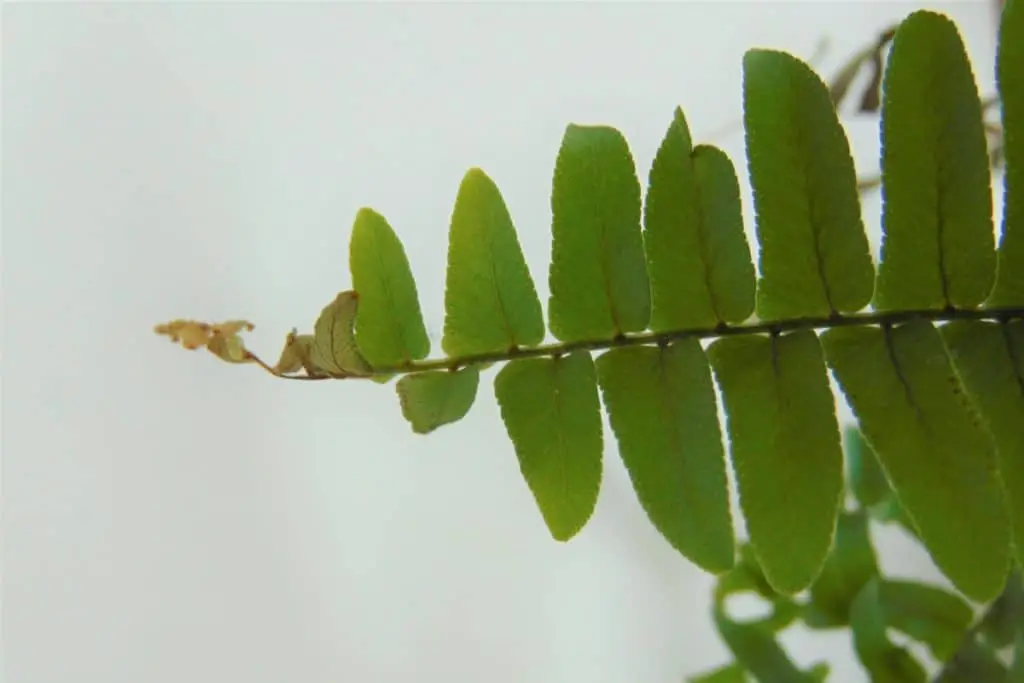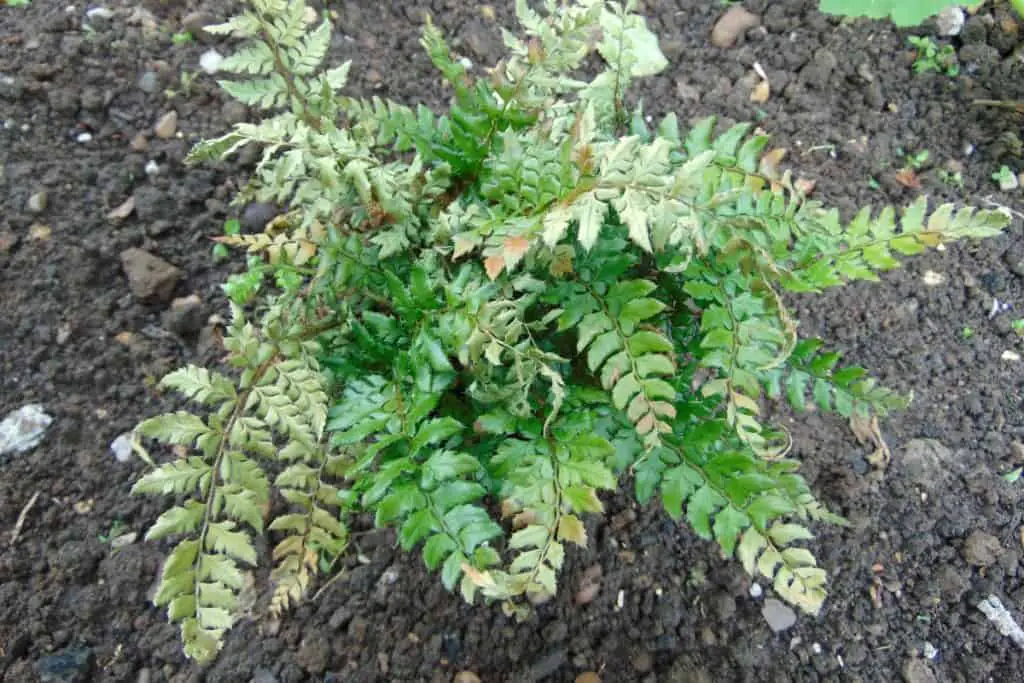The great selling point for ferns is their beautiful foliage, and so it’s especially disappointing if a fern becomes discolored and turns brown. Unfortunately, there are several ways that a fern can suffer from browning, and identifying the likely cause depends on the type of damage that occurs.
The cause of a fern turning brown can be diagnosed from the pattern of the discoloration. The commonest causes are problems with humidity, watering, soil condition, and sunlight. How many fronds are affected, whether it is just the tips or edges, and the color of the damaged pinnae can be used to identify the likely problem.
It is obviously difficult to solve the problem of a fern turning brown and dying without a good idea of what is causing the damage. Here are eight of the commonest ways that ferns can become discolored, and how to solve the issues.
1. Brown tips on fronds
If the fern is generally in good condition, but the very tips of the fronds are turning brown and papery, the likely problem is that the air in the room is too dry.

Underwatering may contribute, but that also tends to result in more widespread browning and die back, and so brown tips in particular are a sign that dry air is the issue. The obvious way to deal with this problem is to increase humidity.
One tactic is to move the fern to a more naturally humid room, such as a bathroom, kitchen, or laundry room. This will reduce the risk of the fronds drying out too quickly. Check too that the fern is not positioned close to a dry heat source like a radiator or air vent.
Another option is to add a pebble tray underneath the pot, to allow any water that drains through the soil during watering to be captured, and then evaporate upwards to increase local humidity. This approach can be improved even further by clustering plants together to help trap even more moisture in a bushy corner.
Finally, if you have the patience, regular misting of the fern can help to prevent the fine, delicate ends from drying out.
2. Curled brown edges along fronds
If the browning is more widespread and runs along the edges of the fronds causing them to curl, the problem is likely to be a more severe drying out than simple low humidity. This can result from local sources of dry heat, or from underwatering (or both together).
Treatment is similar to dealing with low humidity, but with more attention to the watering frequency that you use. Regularly check the soil for hydration, with a moist surface (but not waterlogged) being the ideal situation.
If the problem recurs, it is worth considering a self-watering pot, hydrostick or similar to take some of the guesswork out of the process (and to help protect against forgetfulness or busy lives!).
3. Brown or yellow fronds around the base of the fern
Another common issue is the presence of brown, discolored or wilted fronds at the base of the plant. Often these can seem stunted and withered compared to more vigorous fronds in the center of the crown. The usual causes of this are age or depletion of the soil nutrients.
Fronds will inevitably become exhausted eventually and die back, as a normal part of the fern’s life cycle. This turnover is most common when new growth pushes the older fronds out to the boundary of the crown, where they eventually die back.
This process can become more severe when the fern is potbound, and has exhausted the potting mix or the root ball has grown too tangled. The solution is to simply prune back these old brown fronds, and repot the fern if it has overgrown its space.
If the roots still have plenty of space, then it may be the soil that has become exhausted and depleted. In this case, a simple liquid fertilizer can be added to a watering to rejuvenate the soil. Ferns do not generally need much fertilizer, so adding a standard balanced mix at 50% strength (i.e. diluted in an equal amount of water) would be sufficient.
4. Browning on one side of the fern
If the discolored foliage is noticeably worse on one part of the plant than elsewhere, the problem is likely to be more specific. Common causes of local browning are positioning the fern in a draft of air, physical damage (such as rubbing against a window or wall), uneven sunlight that either sun-bleaches one side or shadows one side of the fern, or uneven heating near a radiator or other heat source.
The only real solution to this problem is to move the fern to a new location. Prune back any dead or damaged fronds, and the plant will bounce back quickly.
5. Patchy brown or black patterns on the foliage
A more serious problem can result from pest damage by foliar nematodes (also known as leaf and bud eelworms). As with other plants, ferns can become infected by these microscopic worms that feed on leaf material, killing the attacked foliage.
Although foliar nematodes can only be formally confirmed with laboratory analysis, there are clues based on the pattern of the discoloration. Nematodes tend to follow the vascular tissue (veins) of the plant and so cause distinctive stripes or angular blotches on the fronds. This discoloration can be yellow, brown or black.
Often, nematode damage to ferns appears on individual pinnae (leaflets) of a frond, and then begins to spread along the frond, losing pinnae one after another. Because the pest can spread within the plant, the damage becomes progressively more widespread over time.

It is difficult to eliminate nematodes. The best hope is to cut away all the diseased, damaged and discolored fronds down to the crown (dispose of this infected material in the general waste – do not compost). Thoroughly clean all tools after use. Then, repot the fern in fresh potting mix, and separate it from any other plants that could be vulnerable.
If the problem recurs, the only option, unfortunately, is to throw away the infected plant.
6. Pale brown, papery fronds
If the brown fronds are thin, brittle and pale brown or yellow, the likely cause is too much sun or heat. Although some varieties of fern can thrive in direct sunlight, many others need partial or full shade.
Positioning a light-sensitive fern on a windowsill or in a south-facing spot can lead to sun bleaching of the leaves. Similarly, positioning the fern near a radiator or vent or other source of warm, dry air, can lead to the same pattern of papery, brown damage.
As long as the fern has not dried out at the roots due to underwatering, this sort of damage can be remedied with time and care.

Link: Case study on treating sun damage in a Makinoi’s Holly fern.
7. Soft or wet black fronds
If the fronds around the base of the fern are badly discolored (dark brown or black) and soft or mushy to the touch, the likely problem is overwatering. This is an indication that the lower parts of the plant are rotting.
Other clues would be standing water in the pot tray, or a bad smell.
Overwatering ferns is a serious problem that requires urgent treatment – this post provides a step by step guide on how to respond.
8. Widespread browning and dropping of fronds
If the damage to the fern is widespread and comes on suddenly, there are a couple of possible causes.
First, if the browning has set in during fall, it is possible that the variety of fern is a deciduous or semi-evergreen species that will naturally wither as the nights get longer or temperature drops. Although evergreen ferns are more popular as houseplants, it is worth checking that this natural explanation can be ruled out. Our list of ferns is a good place to start.
Another cause of sudden loss of foliage is an environmental shock. This could be a sudden change in temperature, intense sunlight or strong drafts. Another possible cause is root burn due to excessive fertilizer use, or severe drought if the roots and rhizomes dry out.
Another, less obvious, cause of shock could be in the water supply – excessively cold or hot water can shock the roots, and very hard water can alter the soil pH and shock acid-loving varieties.
The best way to deal with this sort of sudden change is to stabilize the environment. Make sure the fern is well positioned away from direct sun and heat, and watered regularly. If the damage to the roots and rhizome is not too severe, the plant should recover.
By careful review of the type of browning that your fern has suffered it is possible to identify the likely cause. As ever, the three critical elements of sun, water and temperature are the commonest problems. Fortunately, most causes can be remedied, and the beauty of the fern’s foliage restored.
